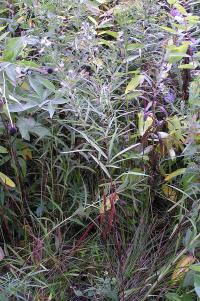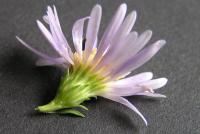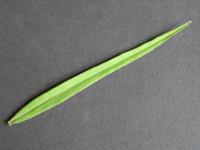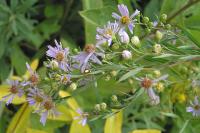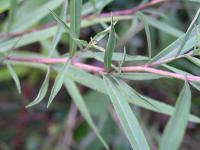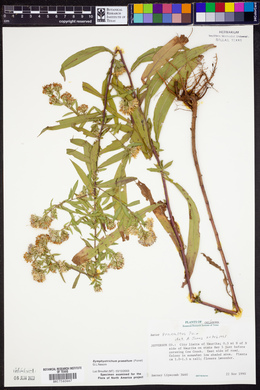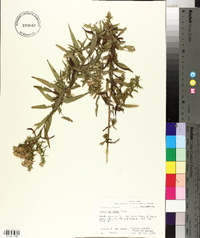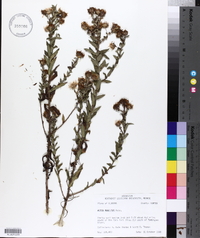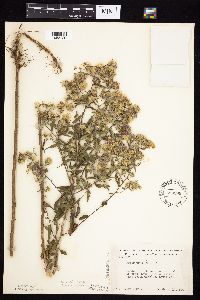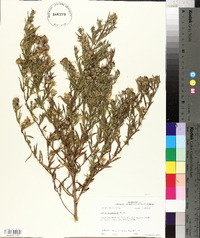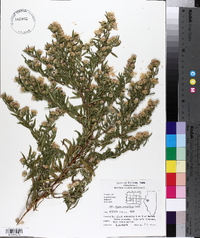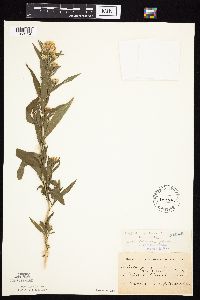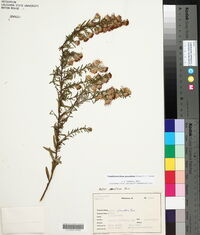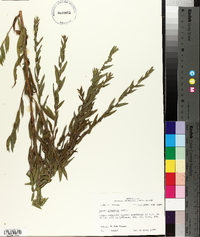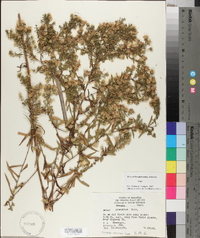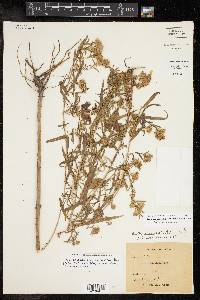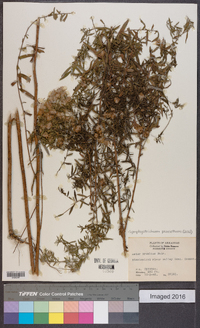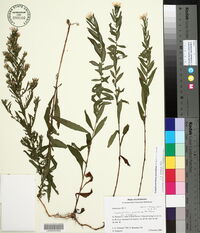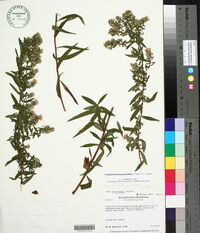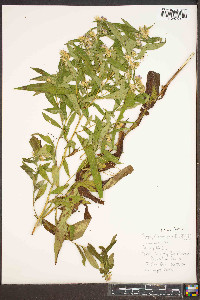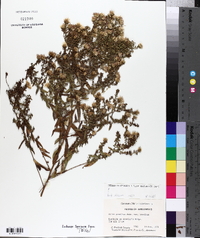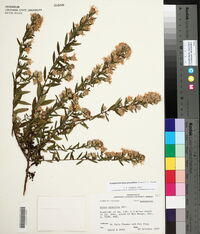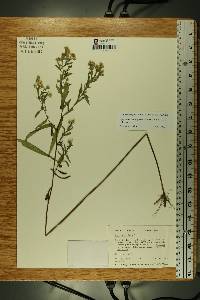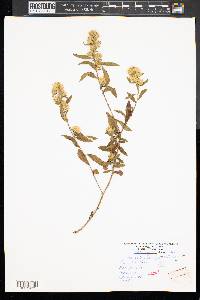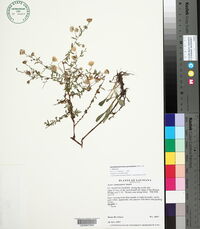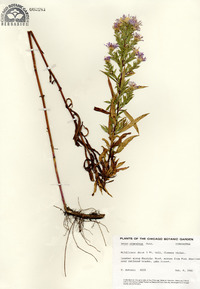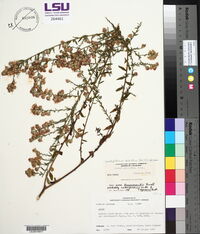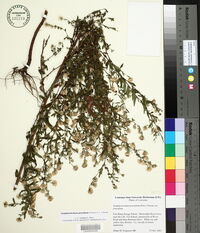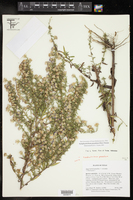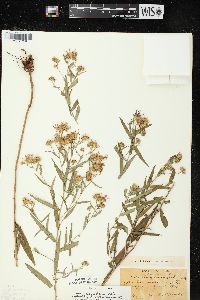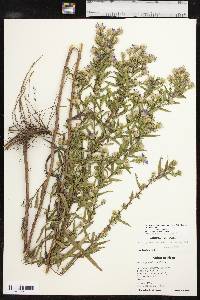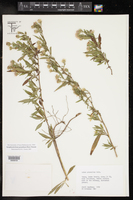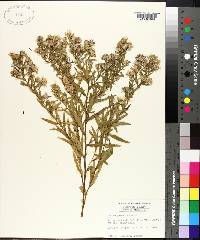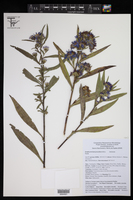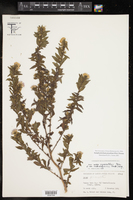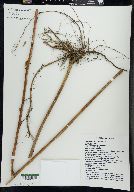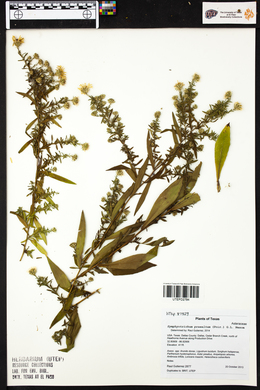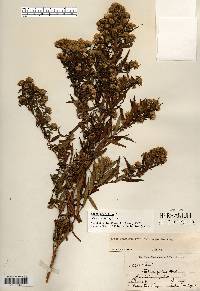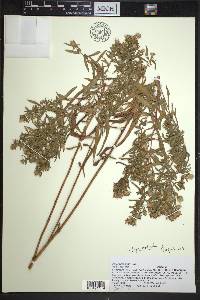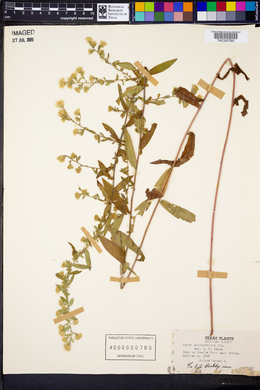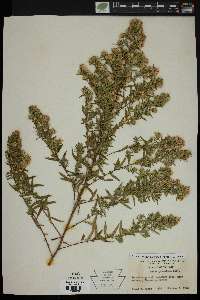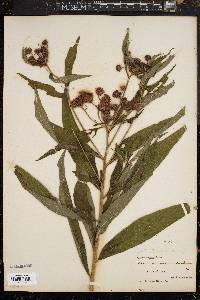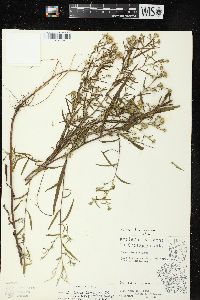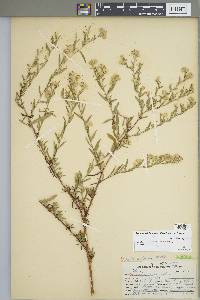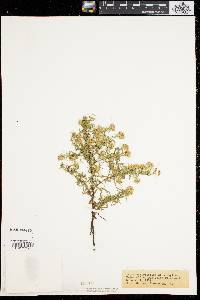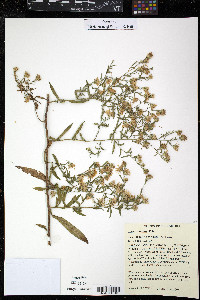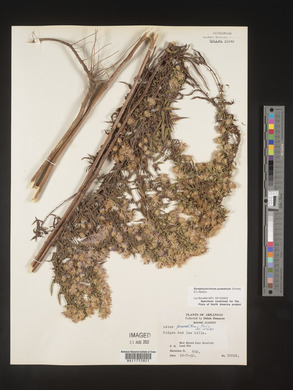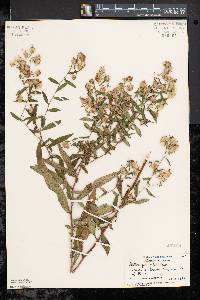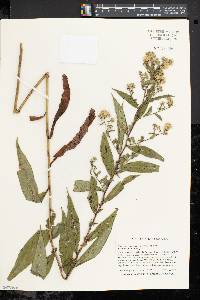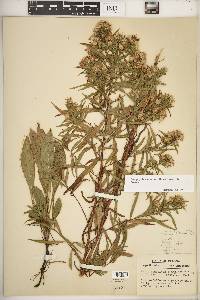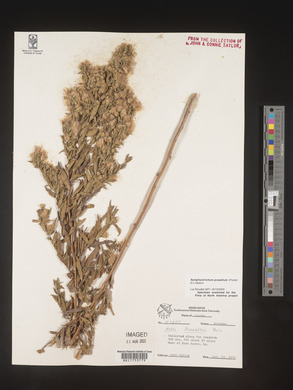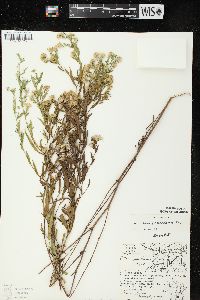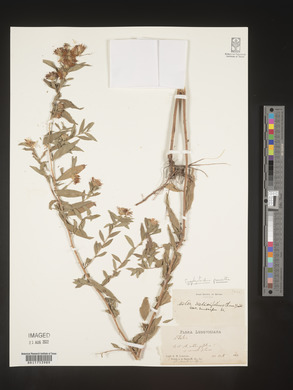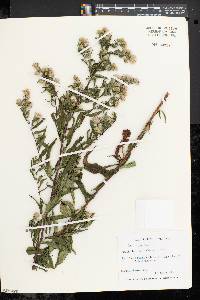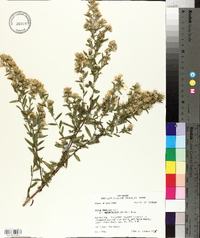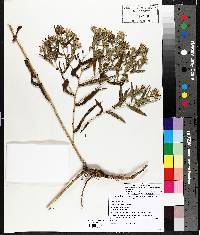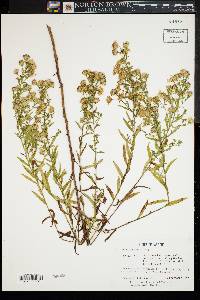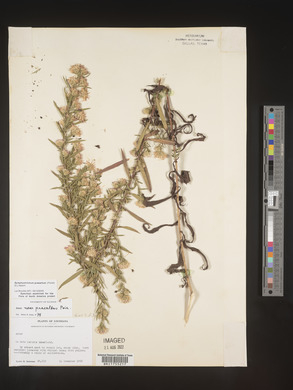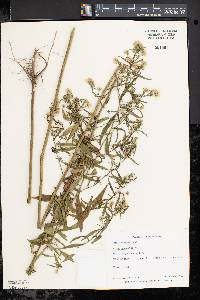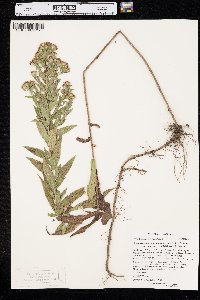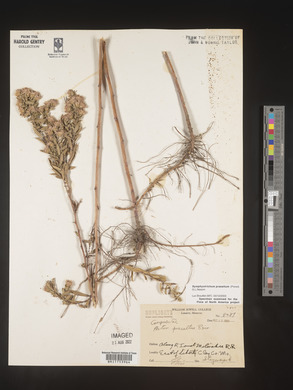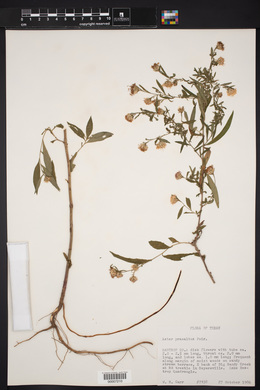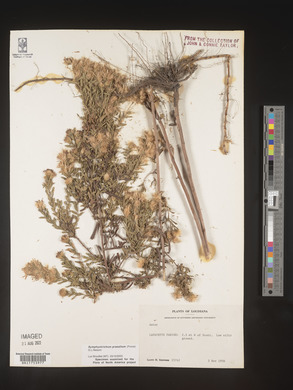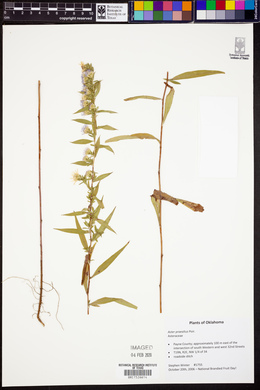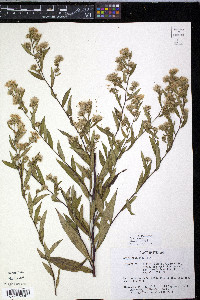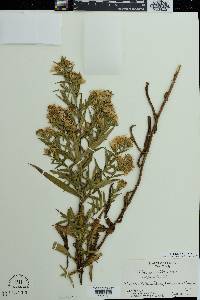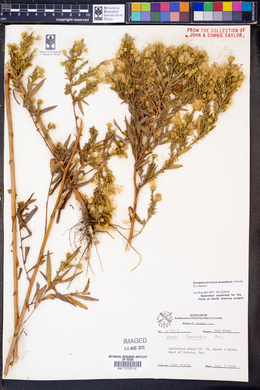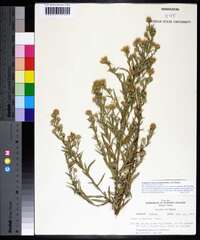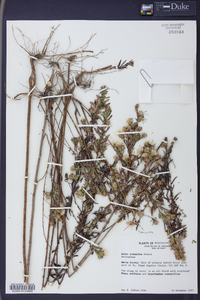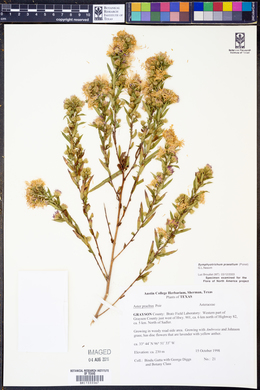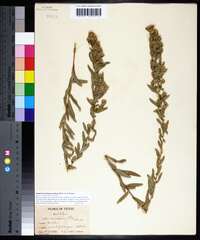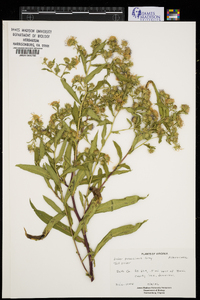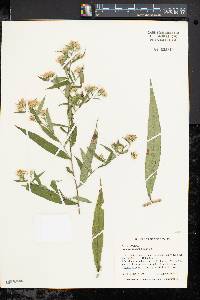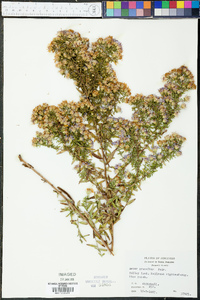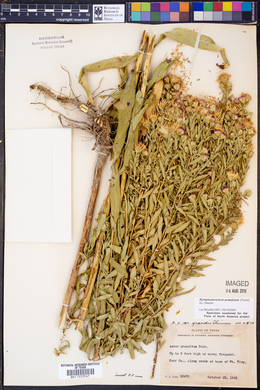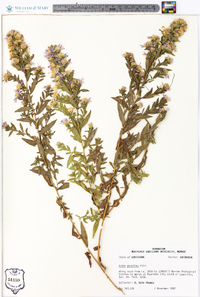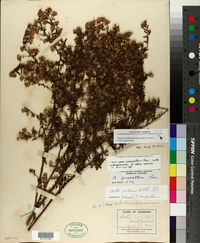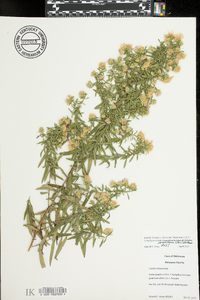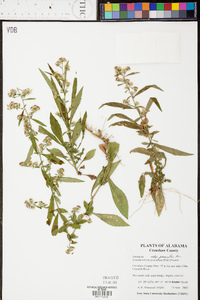
|
|
|
|
Family: Asteraceae
Willow-Leaf American-Aster, more...willowleaf aster
[Aster coerulescens DC., moreAster praealtus Poir., Aster praealtus praealtus , Aster praealtus var. praealtus] |
Perennials (10-)50-150(-200) cm, colonial; fleshy long-rhizomatous. Stems 1, erect to ascending (stout, ± glaucous or reddish), glabrate to moderately hispidulous-hirsute (mostly in lines) distally. Leaves thick, firm, margins often revolute, scabrous, apices mucronate, abaxial faces glabrous, vein areoles conspicuous, ± isodiametric, adaxial waxy, glabrate to strigose, ± scabrous (distal cauline with axillary leaf clusters, sometimes becoming branches); basal withering by flowering, petiolate to subpetiolate (petioles winged, bases sheathing, ciliate), blades spatulate, 40-70 × 10-25 mm, bases attenuate, margins entire to shallowly serrate, apices rounded to obtuse; proximal cauline withering by flowering, sessile (subpetiolate), blades elliptic or lanceolate to oblanceolate or linear-lanceolate, 40-100(-150) × 3-18 mm, progressively reduced distally, bases cuneate, often slightly rounded, apices acute to attenuate, callus-pointed, abaxial faces scabrellous, adaxial glabrous or ± puberulent; distal sessile, blades ovate or elliptic-lanceolate to lanceolate or linear, 10-85 × 2-17 mm, progressively reduced distally, bases cuneate, margins entire, apices acute or obtuse, callus-pointed. Heads in ample, foliaceous, usually dense, paniculiform arrays, branches ascending to spreading, ± racemiform. Peduncles 0.3-2 cm, ± pilose, bracts 5-12+, ascending or recurved-spreading, lance-elliptic to lanceolate or linear-lanceolate, foliaceous, distal closely subtending heads, not grading into phyllaries. Involucres campanulate, (4-)5-7(-8) mm. Phyllaries in 4-6 series, appressed, oblong-lanceolate to linear (innermost) (outer sometimes ± foliaceous), unequal, bases indurate 1 / 2 - 3 / 4 , margins scarious, erose, hyaline, sparsely ciliolate (often ciliate basally), green zones lanceolate to lance-rhombic, apices sometimes spreading, acute to acuminate, mucronate, often reddish purple apically, faces glabrous. Ray florets (6-)20-35; corollas pale blue-violet to lavender or rose-purple, rarely white, laminae 5-10(-12) × 1-1.7 mm. Disc florets 20-30(-35+); corollas cream or light yellow turning pinkish purple, 4-6.5 mm, tubes shorter than narrowly funnelform throats, lobes lanceolate, 0.5-1.3 mm. Cypselae purple or stramineous with purple, obovoid, sometimes ± compressed, 1.5-2 mm, 4-5-nerved, faces thinly strigillose; pappi white, 4-6.5 mm. 2n = 32, 48, 64 Flowering Aug-Oct. Wet, loamy soils, wet prairies or meadows, lake and stream shores, oak savannas, open woods or thickets, fields, moist banks, ditches, roadsides, recent clearings; 0-400+ m; Ont.; Ala., Ark., Conn., Del., D.C., Fla., Ill., Ind., Iowa, Kans., Ky., La., Maine, Md., Mass., Mich., Miss., Mo., Nebr., N.H., N.J., N.Y., Ohio, Okla., Pa., R.I., S.Dak., Tenn., Tex., Va., W.Va., Wis.; Mexico (Chihuahua, Coahuila, Nuevo Léon); introduced in Europe. Symphyotrichum praealtum was reported by H. R. Hinds (2000) as a possible introduced, non-persisting ephemeral in New Brunswick. The species is introduced in central Europe, where it has been confused with S. lanceolatum (J. C. Semple et al. 2002). A. G. Jones (1989) reported hybridization with S. lanceolatum and S. firmum. G. L. Nesom (1994b, 1997) and J. C. Semple et al. (2002) recognize several varieties within the species: var. praealtum [syn. Aster coerulescens de Candolle, A. praealtus var. coerulescens (de Candolle) A. G. Jones, A. praealtus var. imbricatior Wiegand] (2n = 32); var. angustior (Wiegand) G. L. Nesom (syn. A. praealtus var. angustior Wiegand) (2n = 64); var. nebraskense (Britton) G. L. Nesom (syn. A. praealtus var. nebraskensis Britton); var. subasperum (Lindley) G. L. Nesom [syn. A. praealtus var. subasper (Lindley) Wiegand, A. subasper Lindley]; and var. texicola (Wiegand) G. L. Nesom (syn. A. praealtus var. texicola Wiegand). Some of these varieties deserve recognition, but the validity of others needs confirmation.
FNA 2006, McDougall 1973, Allred and Ivey 2012 Duration: Perennial Nativity: Native Lifeform: Forb/Herb General: Perennial herbs, 10- 150 cm or more tall, from long fleshy rhizomes, forming colonies; stems stout, the upper portions appressed-pubescent in lines; branches spreading, at least above the middle. Leaves: Basal and lower stem leaves withering by flowering, petiolate, spatulate, 4-7 cm long with entire to shallowly serrate margins; stem leaves alternate, the upper leaves sessile and reduced in size; blades ovate or elliptic-lanceolate to lanceolate or linear, 1-9 cm long, with entire, usually revolute margins. Flowers: Flower heads showy, radiate, blue-purple or white with light yellow centers, quite numerous in dense panicles, the panicle branches ascending-spreading and usually racemose; each peduncle with 1-3 bracts; involucres campanulate, 5-7 mm high, the phyllaries in 4-6 graduated series, oblong-lanceolate to linear, straw-colored with a green patch near the tip, sometimes red or purple-tipped; ray florets 6-35 per flower head, the laminae (ray petals) 5-10 mm long, light blue, lavender, pink, or white; disc florets cream or light yellow, turning light purplish-blue. Fruits: Achenes purple or with purple lines, obovoid, compressed, 2 mm long, thinly covered with stiff hairs; topped with a pappus of white capillary bristles, 4-7 mm long. Ecology: Found in wet, loamy soils, in prairies, meadows, lake and stream shores, oak savannas, open woods or thickets, fields, moist banks, ditches, roadsides, and recent clearings, below 8,000 ft (2438 m); flowers August-October. Distribution: New England and Ontario south to FL, west to NM, CO, and SD Notes: The dense, spike-like sprays of the inflorescence help distinguish this species. In the Flora Neomexicana key (Allred and Ivey) it shares a final couplet with the more common S. lanceolatum: S. lanceolatum has thin leaves with flat margins; linear-lanceolate outer phyllaries; and 5-12 or more bracts on each peduncle. S. praealtum has firm leaves with often revolute (downward-curling) margins; oblong-lanceolate outer phyllaries; and 1-3 bracts on each peduncle. S. praealtum is an eastern species which has been collected only a handful of times in the Southwest. FNA shows its distribution going only as far west as Texas, however Allred and Ivey list it as present but rare in New Mexico's central mountains and the middle and upper Rio Grande drainage. Ethnobotany: A decoction was used ceremonially for snakebite; a cold infusion of the whole plant was used as a ceremonial eyewash, for internal injury, for stomachache, and to revive an unconscious patient; and the dried leaves were smoked for good luck in hunting. Etymology: Symphyotrichum comes from Greek symphysis for borne together and trichnos for hair, referring to the basally connected pappus bristles on the first described member of the genus; praealtum is Latin for very tall or very high. Synonyms: Aster praealtus, A. salicifolius, and others. Editor: LCrumbacher 2011, AHazelton 2017 Much like no. 12 [Aster lanceolatus Willd.]; lvs thick and firm, conspicuously reticulate beneath with nearly isodiametric areolae, entire or nearly so, scabrous to subglabrous above, glabrous or scabrous-puberulent beneath, the main ones 7-13 cm נ8-18 mm; invol 5-7(-8) mm; rays 6-15 mm, bluish-purple or rarely white; lobes of the disk-cors comprising 17-25% of the limb; 2n=32, 64. Moist low ground; Mich. to Ga. w. to Neb., s. Ariz., and n. Mex.; Irregularly and rarely e. to Mass., N.Y., N.J., and Md. (A. salicifolius, a preoccupied name) The otherwise more western var. nebraskensis (Britton) Wiegand, with the stem and often also the lower lf-surfaces more uniformly and conspicuously spreading-puberulent, has been reported from Io. (A. nebraskensis; ? A. woldeni) Gleason, Henry A. & Cronquist, Arthur J. 1991. Manual of vascular plants of northeastern United States and adjacent Canada. lxxv + 910 pp. ©The New York Botanical Garden. All rights reserved. Used by permission. From Flora of Indiana (1940) by Charles C. Deam This species is essentially an inhabitant of moist, prairie habitats. Infrequent in moist prairie habitats and less often in moist, black loam about lakes and in marshes and in low, open woods. [Variety subasper] was reported by Wiegand (Rhodora 35: 25. 1933) from Indiana, as collected by Dr. Clapp, who did his collecting in the vicinity of New Albany. …… Indiana Coefficient of Conservatism: C = 6 Wetland Indicator Status: FACW |
|
|
|

